For more information and search capabilities visit: Lessons Main Index Page
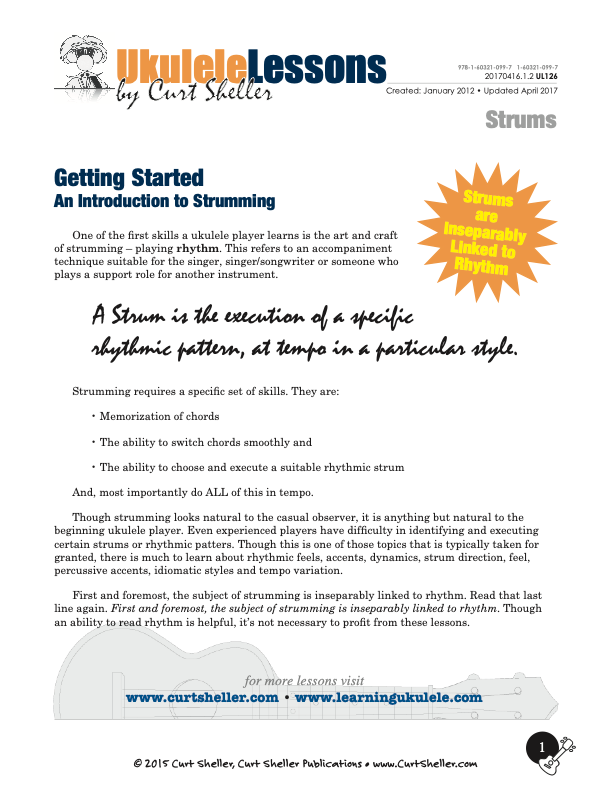
One of the first skills a ukulele player learns is the art and craft of strumming – playing rhythm. This refers to an accompaniment technique suitable for the singer, singer/songwriter or someone who plays a support role for another instrument.

"A strum is the execution of a specific rhythmic pattern, at tempo, in a particular style." A strum can be broken down into its rhythmic syllables. These rhythmic syllables are defined by what particular style is being performed. Basic ukulele strums and variations to get you started.
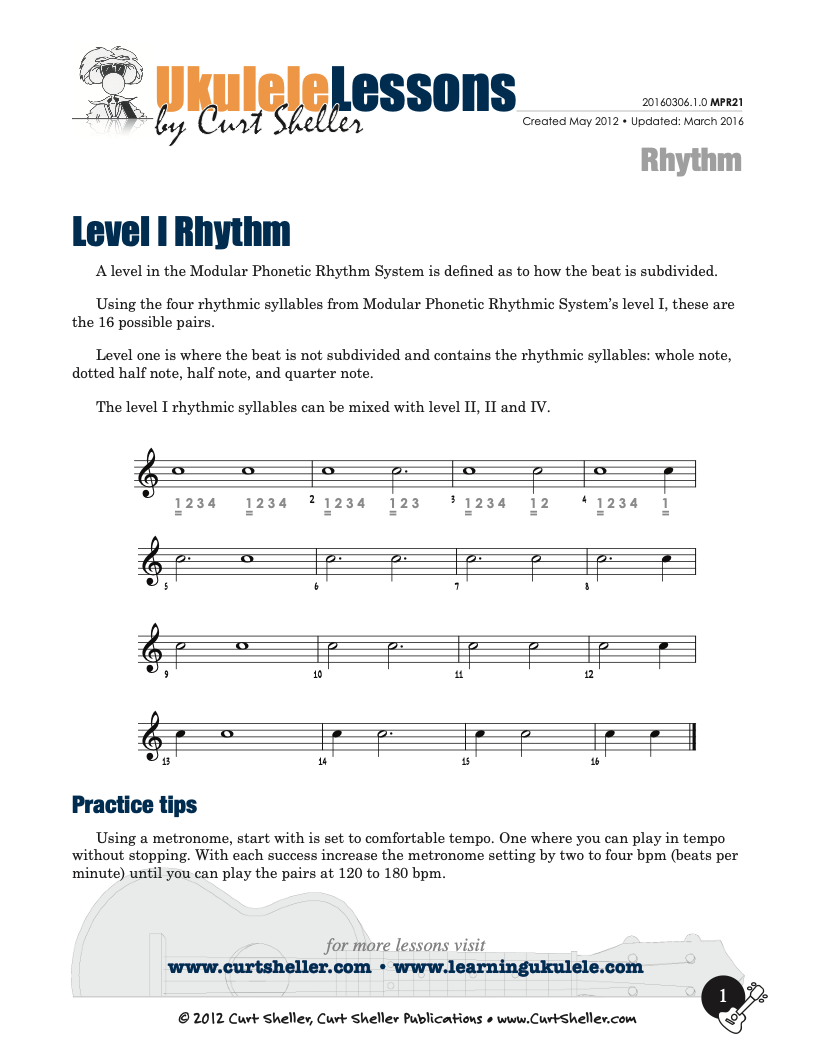
Develop your ukulele strums vocabulary and sharpen your reading chops with the "Level I, Modular Phonetic Rhythmic Syllables — Pairs Worksheet".
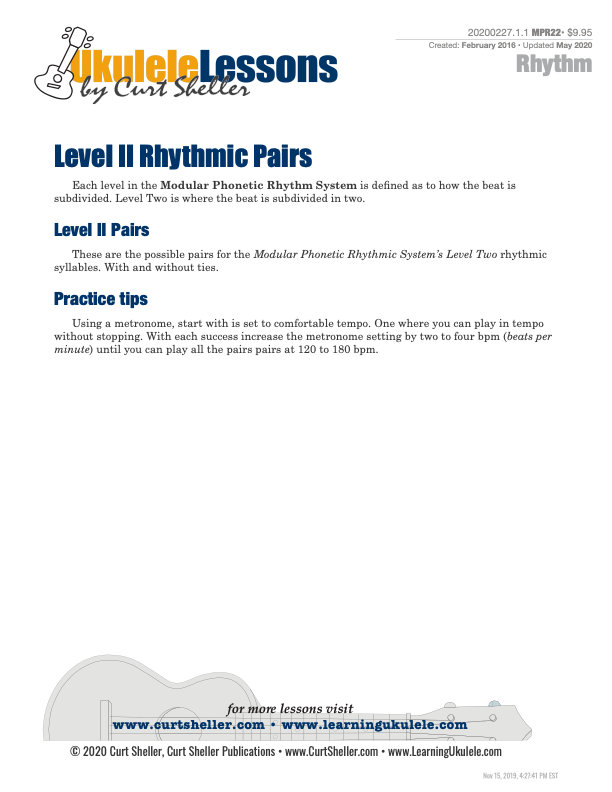
Develop your ukulele strums vocabulary and sharpen your reading chops with the "Level II, Modular Phonetic Rhythmic Syllables — Pairs Worksheet".

"Modular Phonetic Rhythm" by Chuck Anderson represents a significant advance in the teaching and application of rhythm. Eliminating many inefficient aspects of rhythm education, Modular Phonetic Rhythm streamlines the traditional educational approach, resulting in a reflexive reaction to rhythm. This approach is applicable to all ages and to all styles of music.
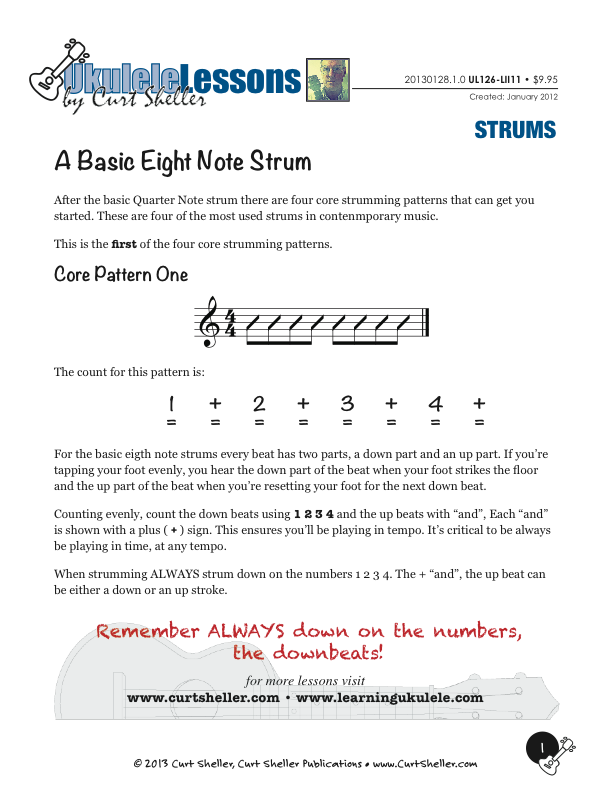
For ukulele there are four core, basic strums that will get you started. This is the first of the four core patterns.
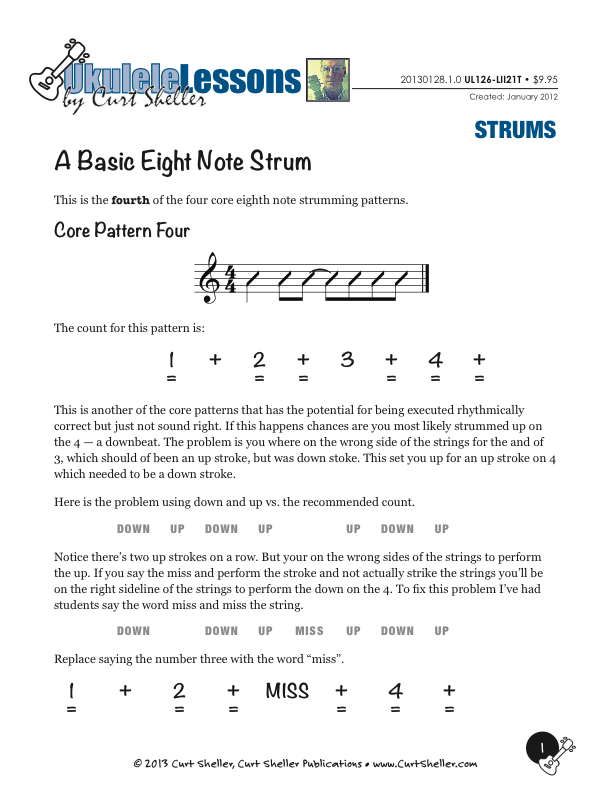
For ukulele, there are four core, basic strums that will get you started. This is the fourth of the four core patterns. This is the famous Island Strum that you will hear a lot in the Ukulele community.
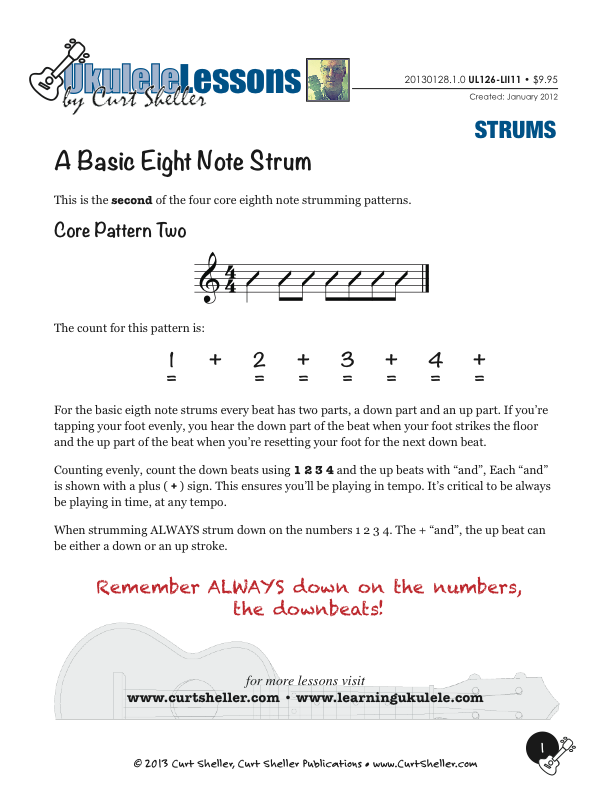
For ukulele and guitar there are four core, basic strums that will get you started. This is the second of the four core patterns.
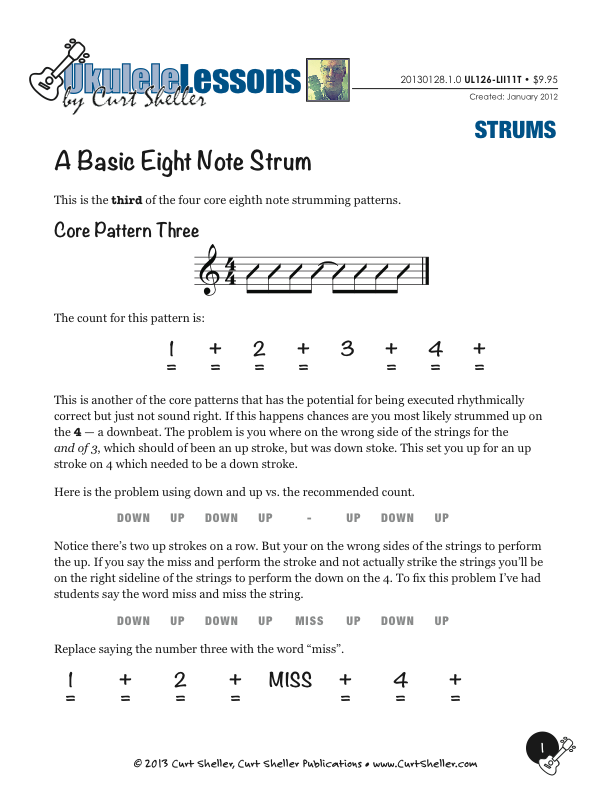
For ukulele there are four core, basic strums that will get you started. This is the third of the four core patterns.
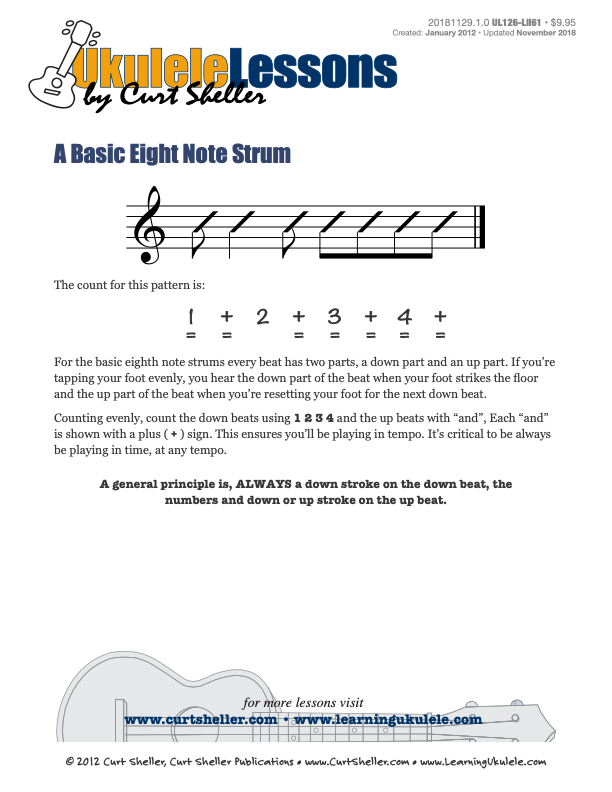
Another one of the 72 possible strumming patterns based of the Modular Phonetic Rhythm system level II rhythmic syllables.
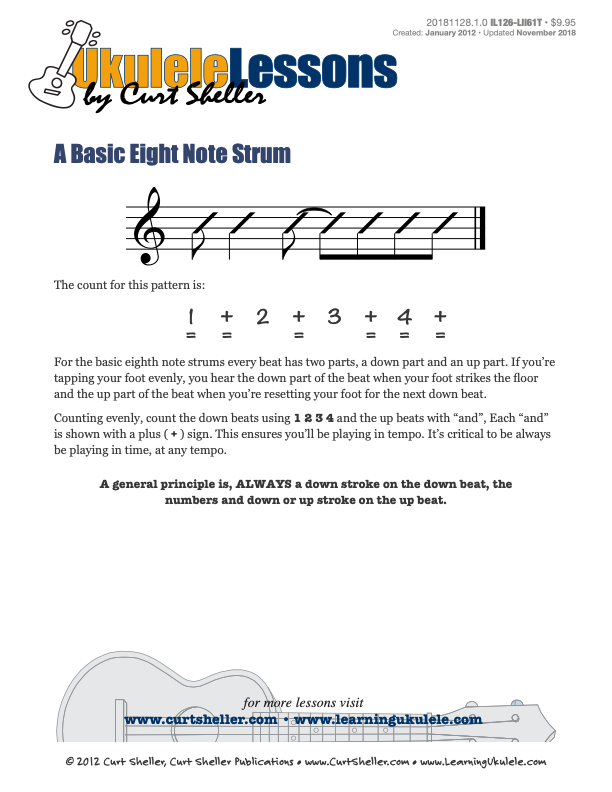
Another one of the 72 possible strumming patterns based of the Modular Phonetic Rhythm systems level II rhythmic syllables.
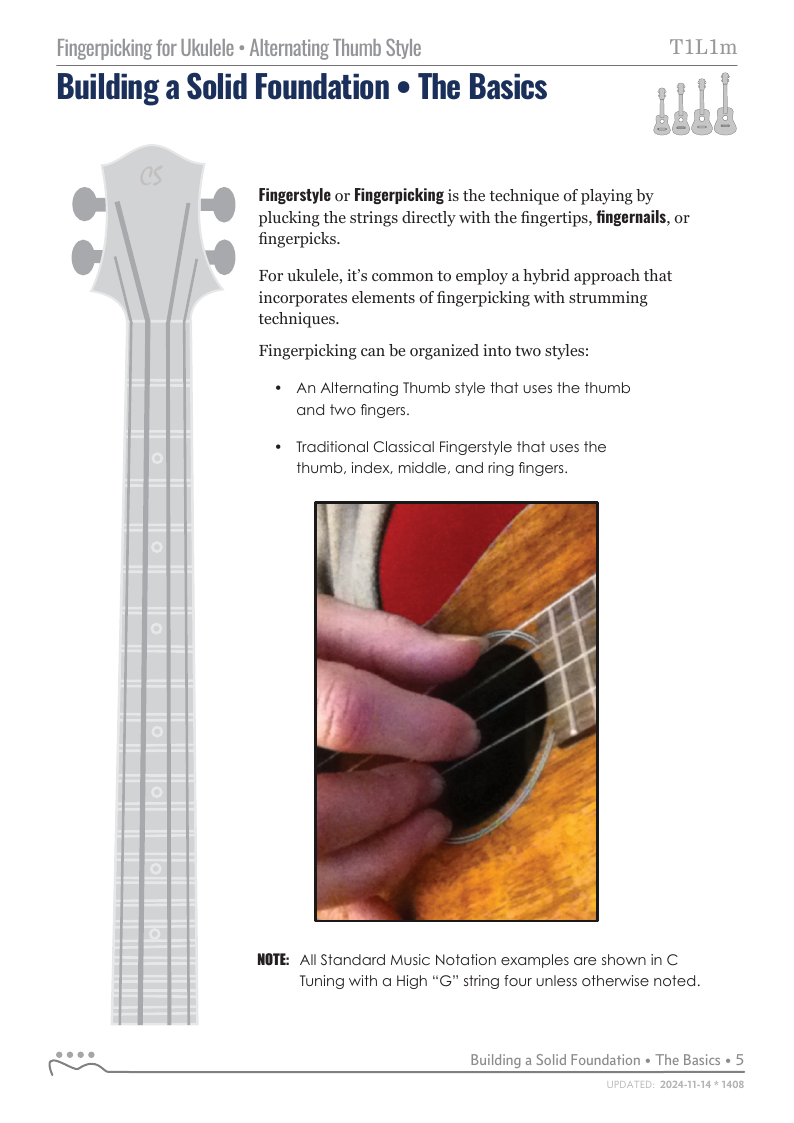
As the subtitle of this Fingerpicking Basics lesson for Ukulele implies, this lesson's focus is on the alternating thumb part of the style. Commonly called Travis Picking on guitar and Scrugg's Style for banjo. For guitar it’s an alternating bass note style with the thumb playing the lower, bass notes.
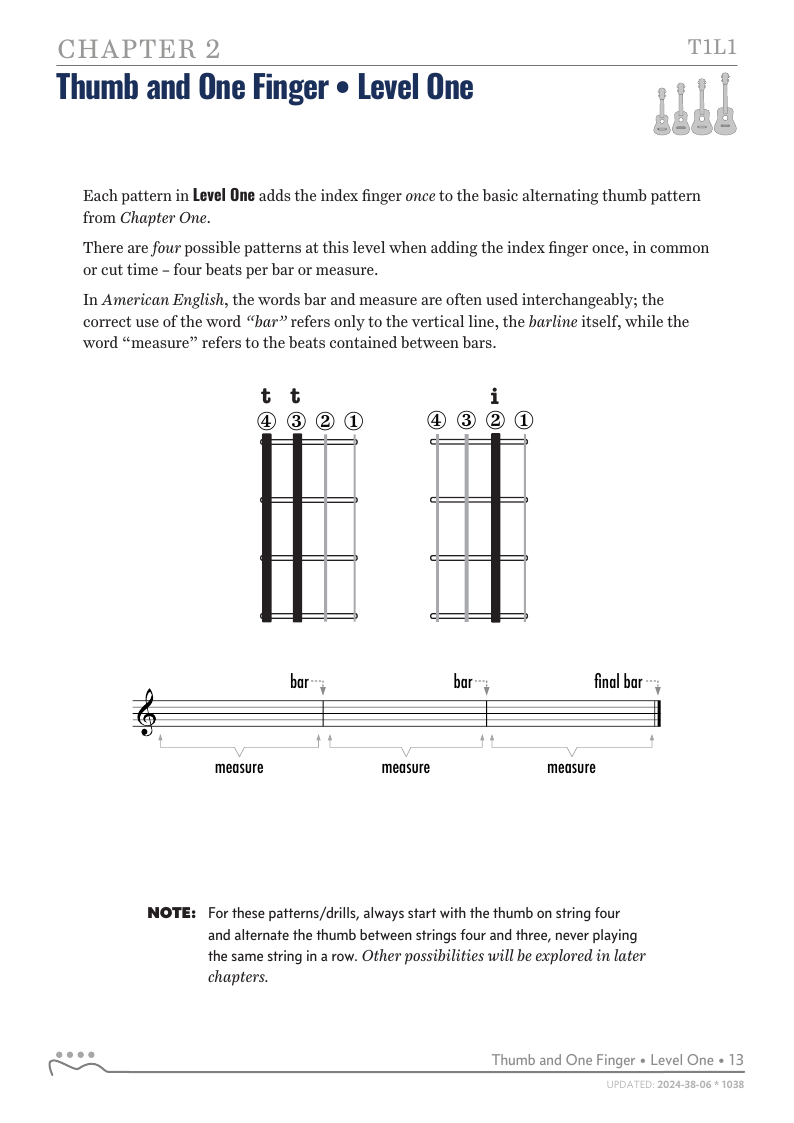
In this lesson we’re introducing the index finger once to the alternating thumb pattern mastered in the Alternate Thumb Fingerpicking Style - Introduction. There are four possible patterns when adding the index finger once in common or cut time.
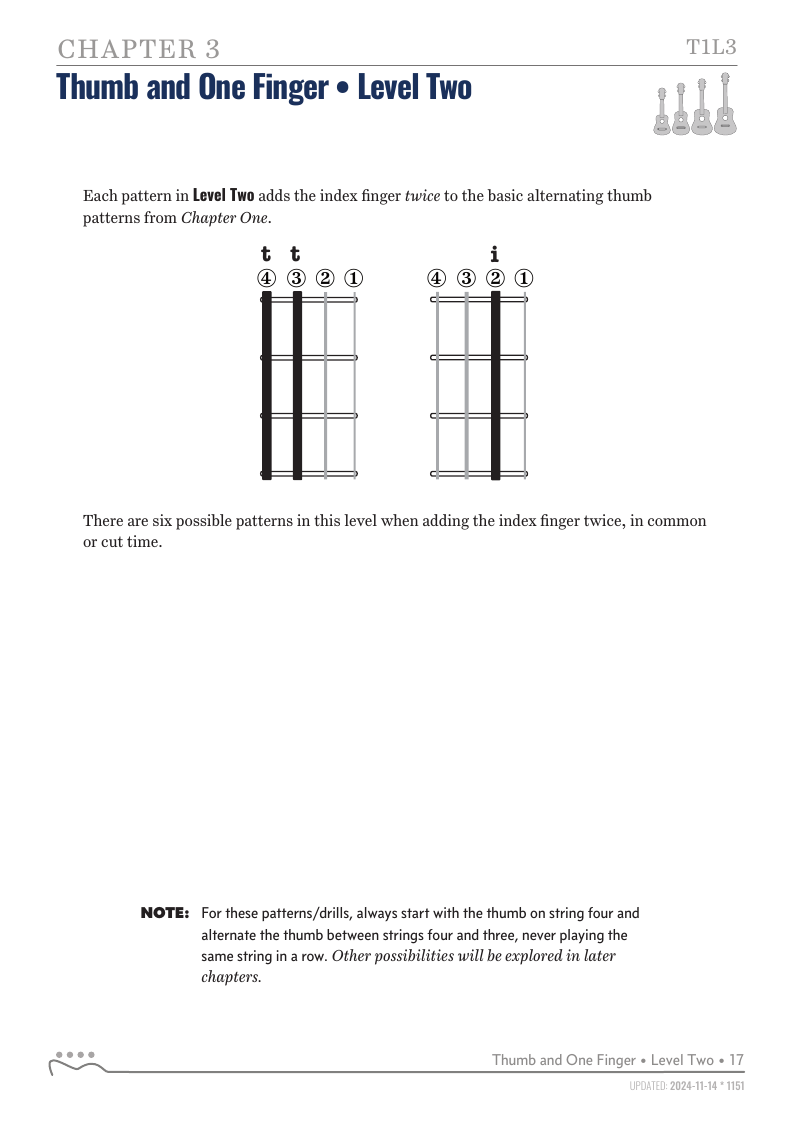
In this lesson we’re introducing the index finger twice to the alternating thumb pattern mastered in the Alternate Thumb Fingerpicking Style - Introduction. There are six possible patterns in common or cut time.ssible variations in this lesson.
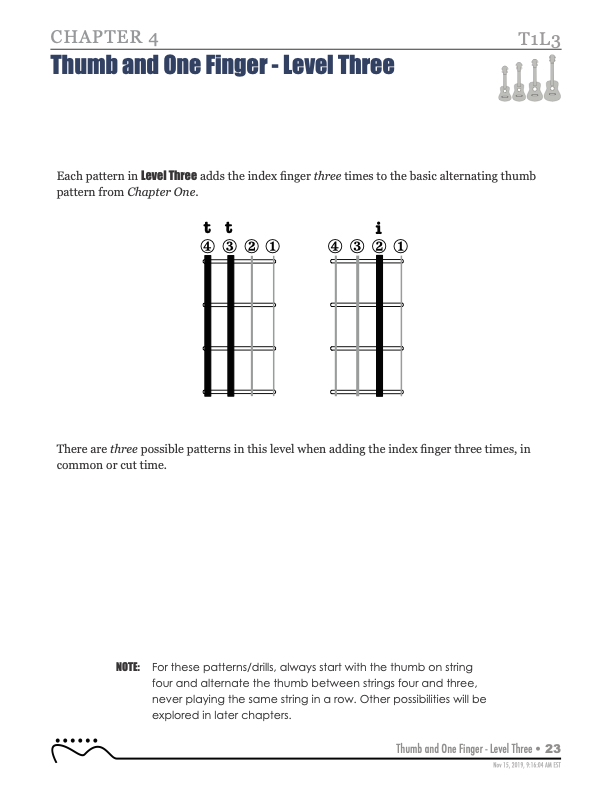
In this lesson we’re introducing the index finger three times to the alternating thumb pattern mastered in the Alternate Thumb Fingerpicking Style - Introduction. There are three possible patterns in common or cut time.
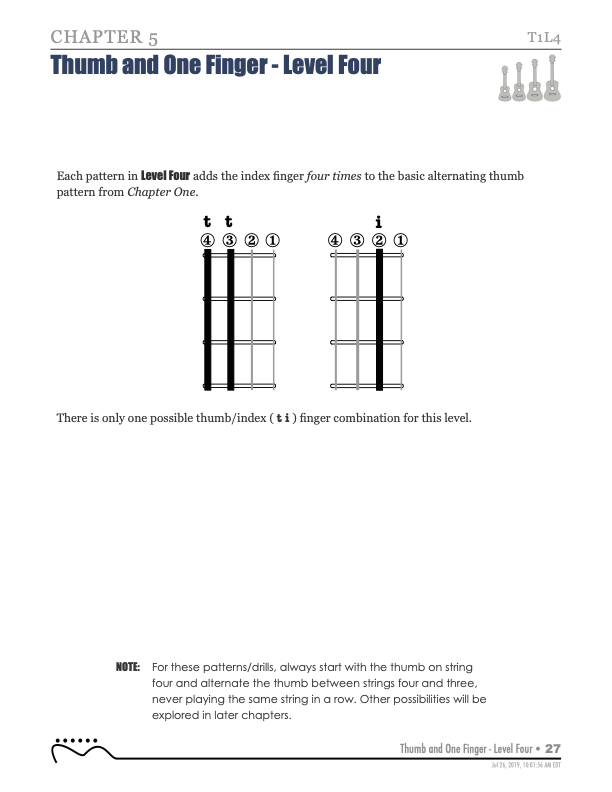
All the previous lessons in the "Fingerpicking for Ukulele, Alternating Thumb Style Series" where melodic, single notes only. This lesson introduces The *Pinch, where any one of the thumb/index finger or thumb/middle finger combinations can be played together - harmonically.
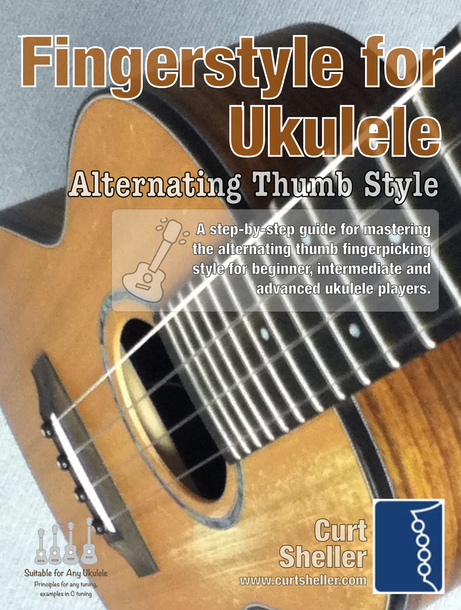
There are two common styles of fingerpicking on ukulele. This series of lessons explores the Alternating Thumb Style. A future series will explore the Thumb and three finger style, the traditional p i m a classical guitar style that we’ll adapt to ukulele.
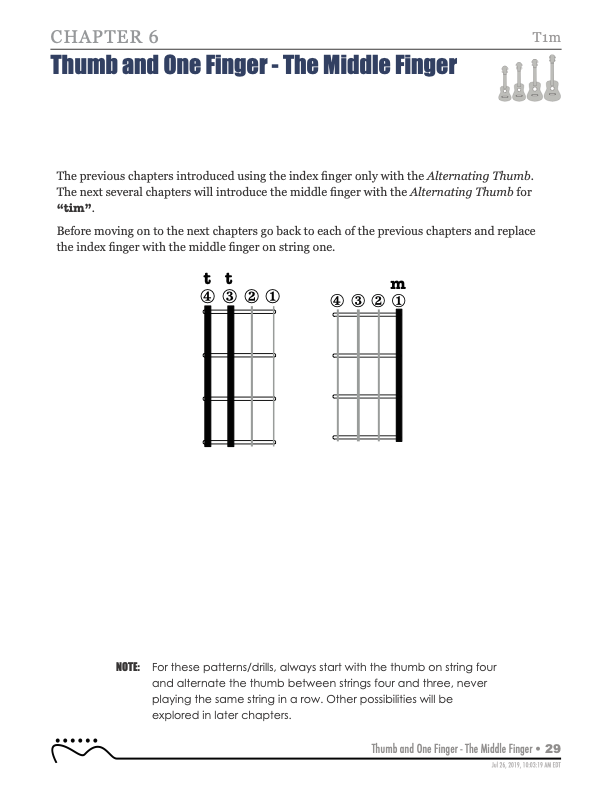
In this lesson we’re reolacing the index finger with the middle finger for the patterns mastered in chapters/lessons two, three and four.
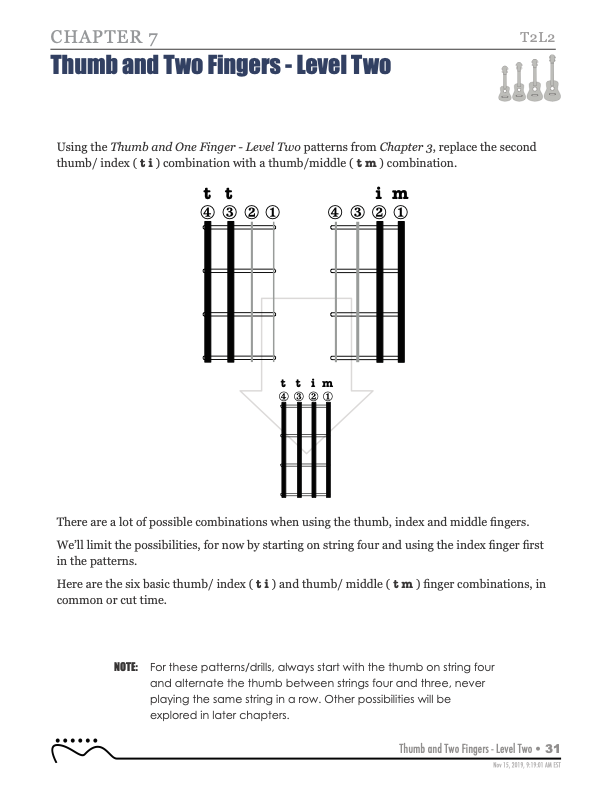
In this lesson we’re introducing the middle finger to the fingerpicking patterns mastered in chapter/lessons four. There are six possible patterns in common or cut time.
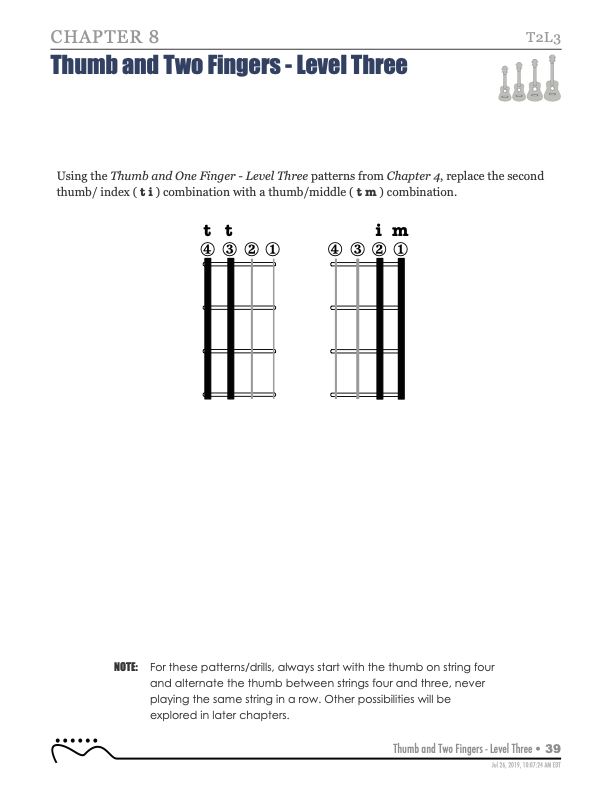
In this lesson we're introducing the middle finger to the fingerpicking patterns mastered in lesson/chapter four. There's three patterns in common or cut time.
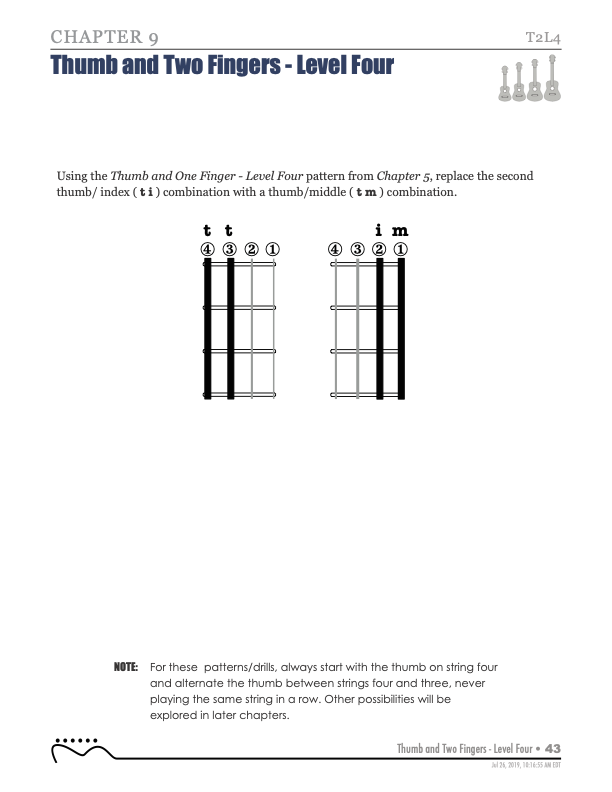
In this lesson we're introducing the middle finger to the fingerpicking patterns mastered in lesson/chapter five. There's only one pattern in common or cut time. this pattern is demonstarted on the four possible string orders.
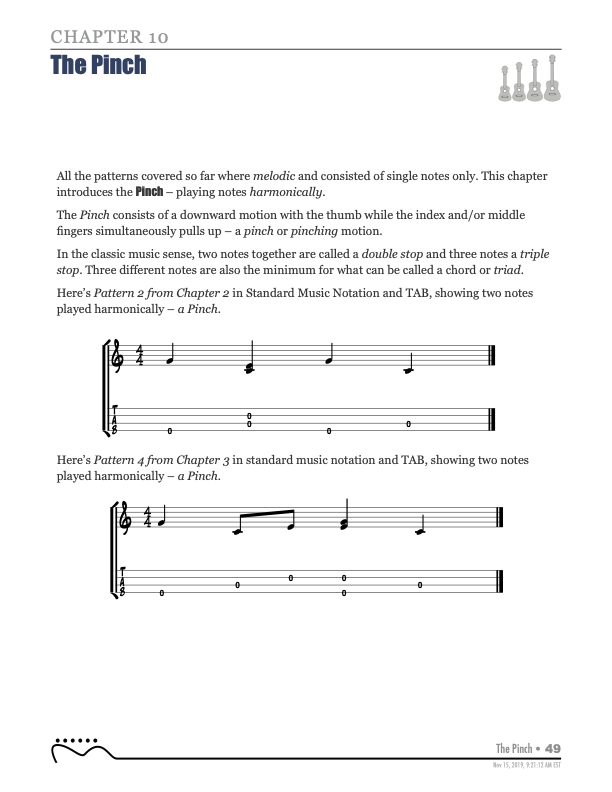
All the previous lessons in the "Fingerpicking for Ukulele, Alternating Thumb Style Series" where melodic, single notes only. This lesson introduces The *Pinch, where any one of the thumb/index finger or thumb/middle finger combinations can be played together - harmonically.
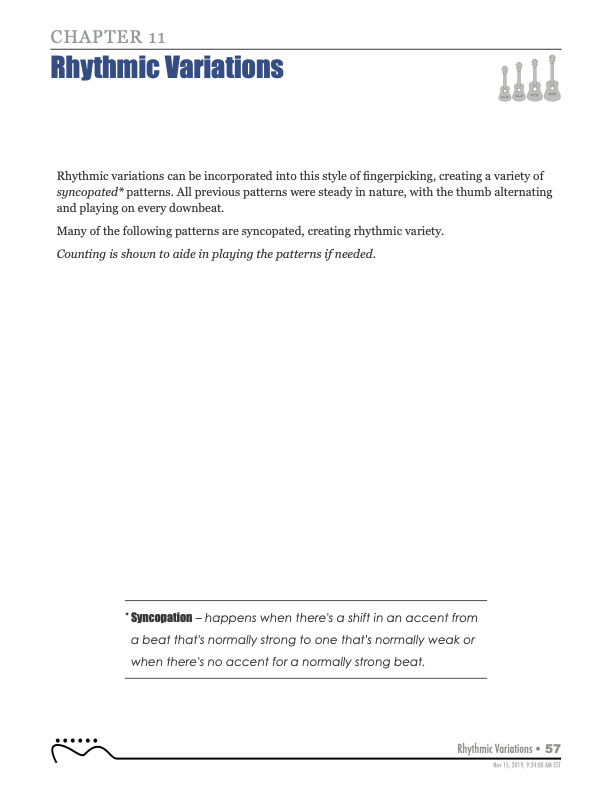
Rhythmic variations can be incorporated into this style of fingerpicking, creating a variety of syncopated patterns. All previous patterns were steady in nature, with the thumb alternating and playing on every downbeat. Many of the following patterns are syncopated, creating rhythmic variety.
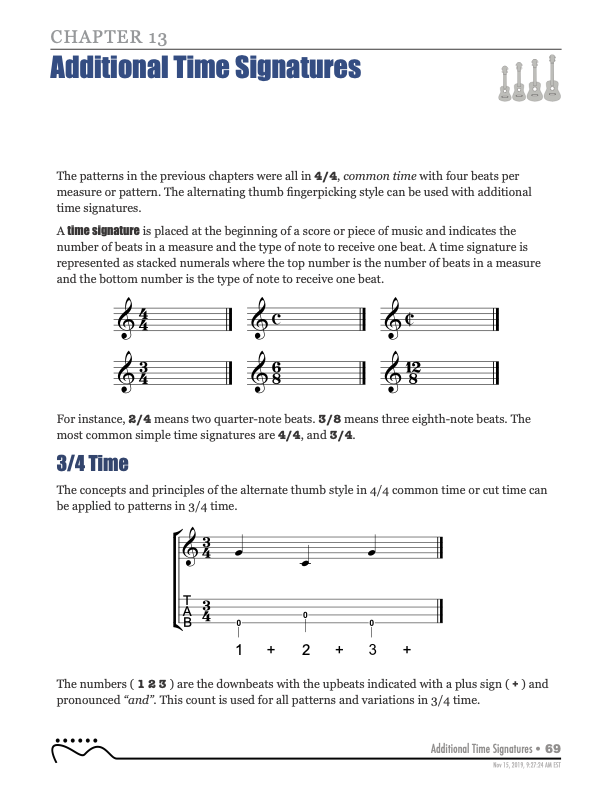
The patterns in the previous chapters were all in 4/4, common time with four beats per measure or pattern. The alternating thumb fingerpicking style can be used with additional time signatures.
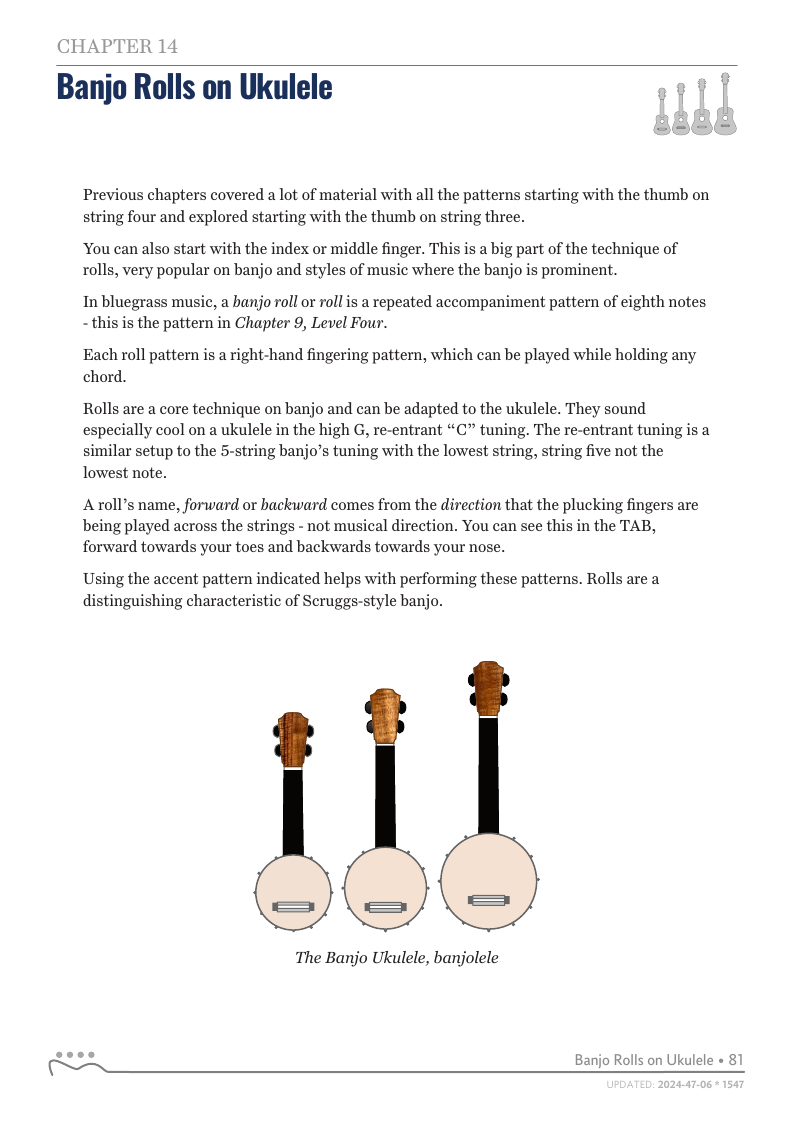
Exploring banjo rolls on ukulele. In bluegrass music, a banjo roll or roll is a repeated accompaniment pattern of eighth notes. Each roll pattern is a right hand fingering pattern, which can be played while holding any chord position.
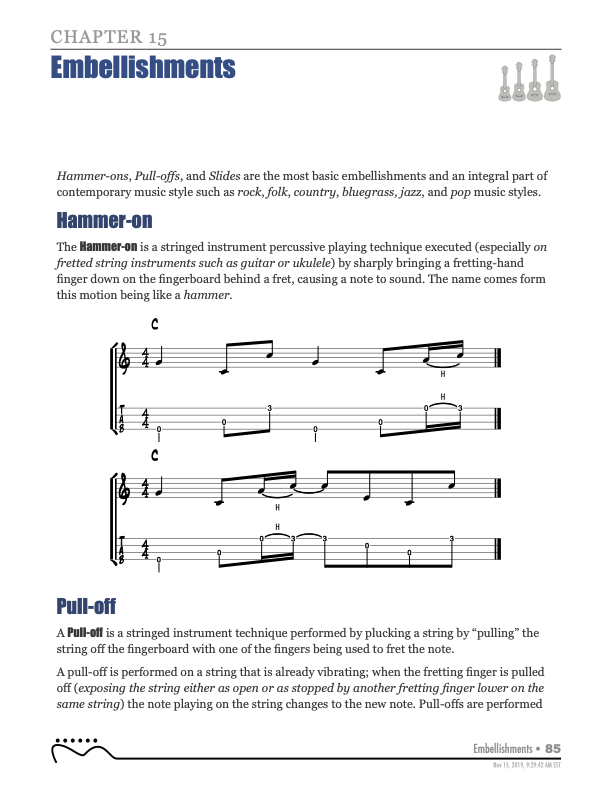
Hammer-ons, Pull-offs, and Slides are the most basic embellishments and an integral part of rock, folk, country, bluegrass, and pop music styles.
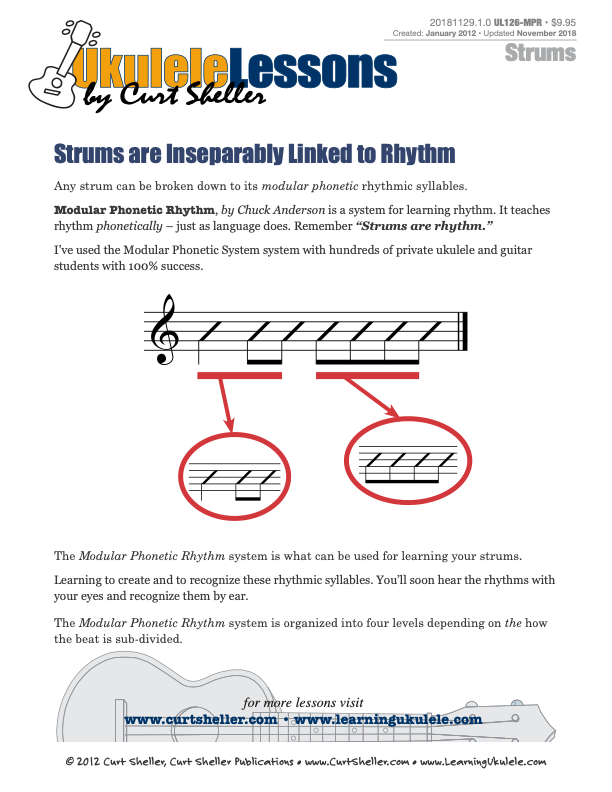
Strums are Inseparably Linked to Rhythm. Any strum can be broken down to its Modular Phonetic rhythmic syllables. Modular Phonetic Rhythm, by Chuck Anderson is a system for learning rhythm. It teaches rhythm phonetically - just as language does. Remember 'Strums ARE rhythm'
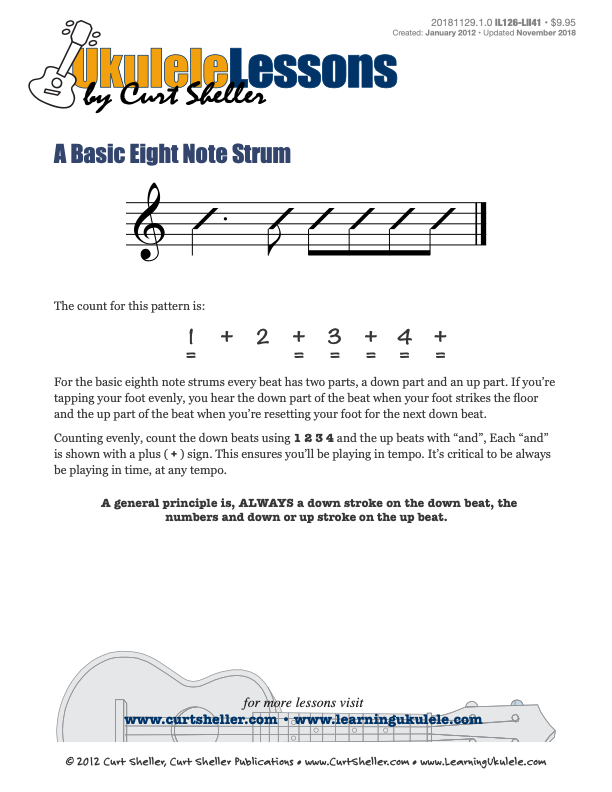
Another one of the 72 possible strumming patterns based of the Modular Phonetic Rhythm systems level II rhythmic syllables. A dotted quarter note and one eight note to four eight notes. Basically one rhythmic rhythmic syllable from the Modular Phonetic Rhythm tied to another syllable from the system.
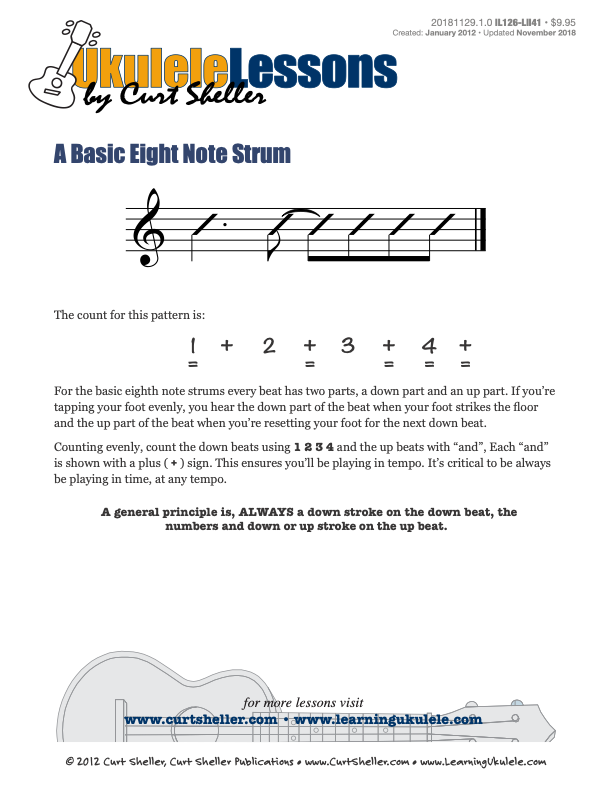
Another one of the 72 possible strumming patterns based of the Modular Phonetic Rhythm systems level II rhythmic syllables. The last pattern in this series with the end of the first rhythmic syllable tied to the beginning of the second rhythmic syllable.
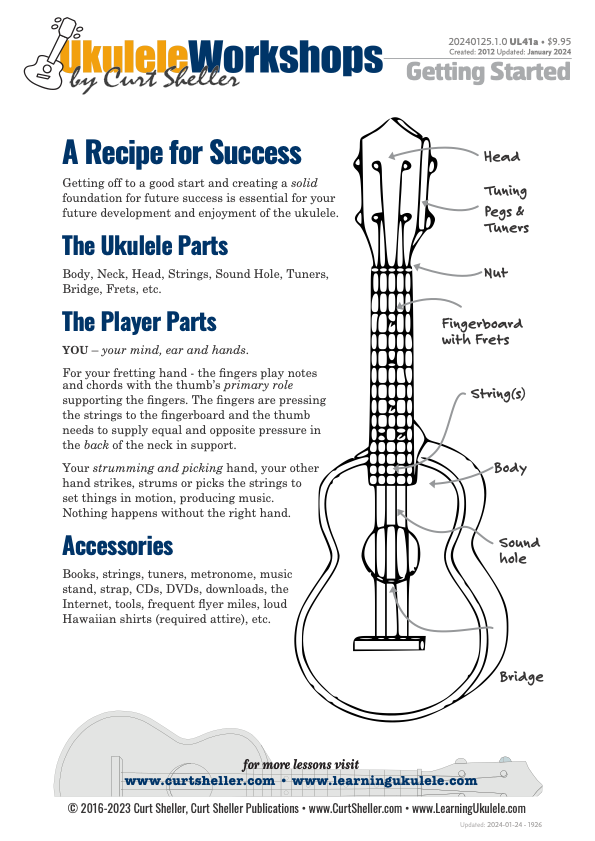
"Where Do I Start?" This is a common question. This workshop/lesson covers ukulele tunings, learning the ukulele fingerboard, basic chords and strums. This workshop gets you rolling on having some fun playing the ukulele. This is the workshop-lesson handout that given to ukulele players attending the "Learning Ukulele - A Recipe for Success" beginner workshop.
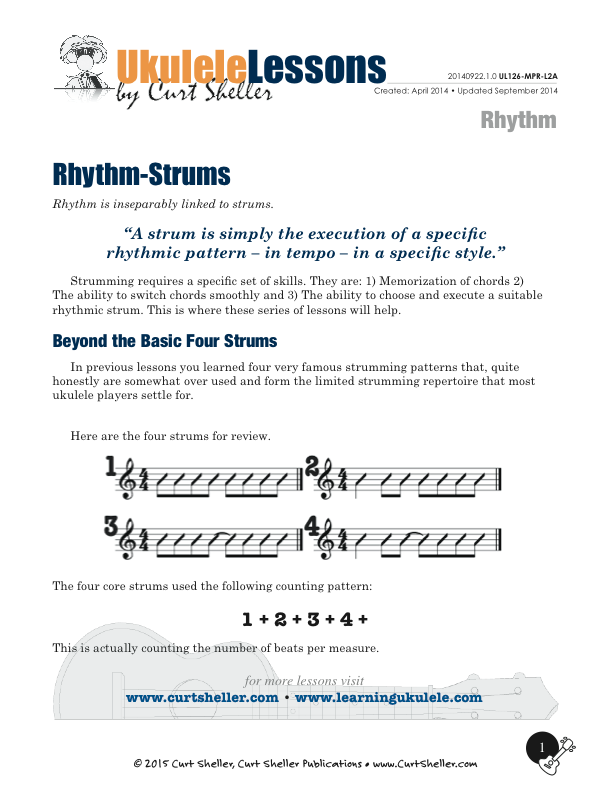
Level II Rhythmic Syllables 1 of 6 and 2 of 6 from the Modular Phonetic Rhythm, The Foundation and Workbook 1 book.
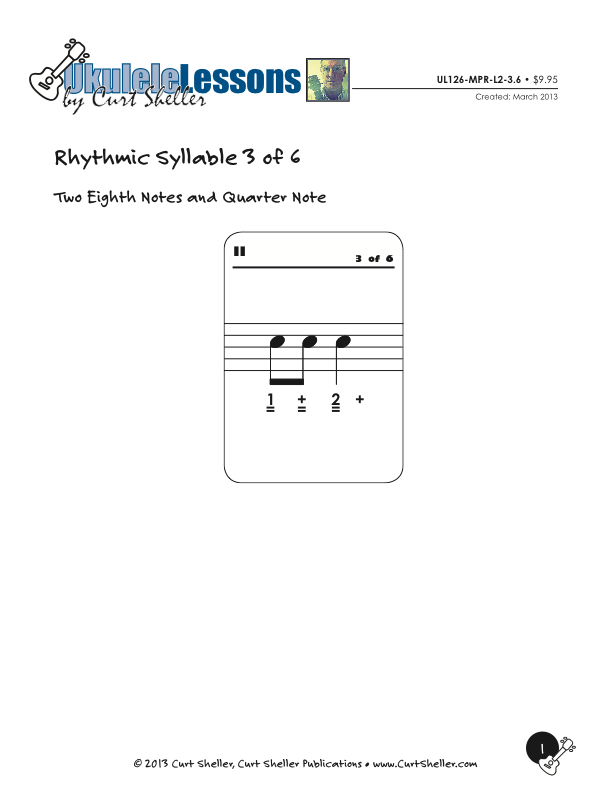
Level II Rhythmic Syllables 3 of 6 from the Modular Phonetic Rhythm, The Foundation and Workbook 1 book.
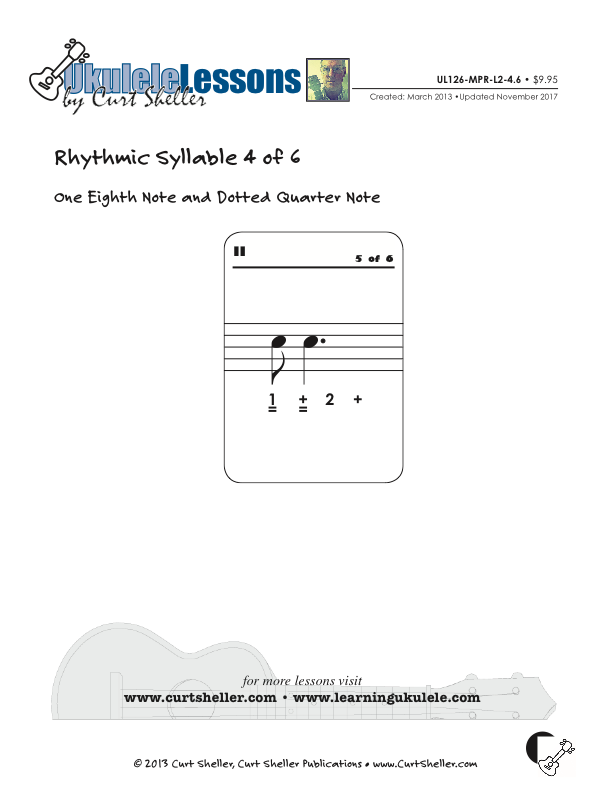
Level II Rhythmic Syllables 4 of 6 from the Modular Phonetic Rhythm, The Foundation and Workbook 1 book.
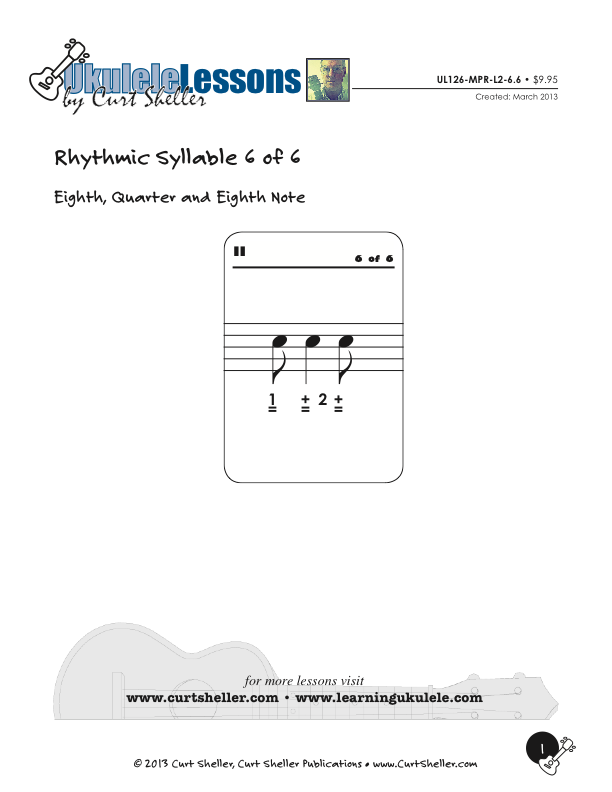
Level II Rhythmic Syllables 6 of 6 from the Modular Phonetic Rhythm, The Foundation and Workbook 1 book.
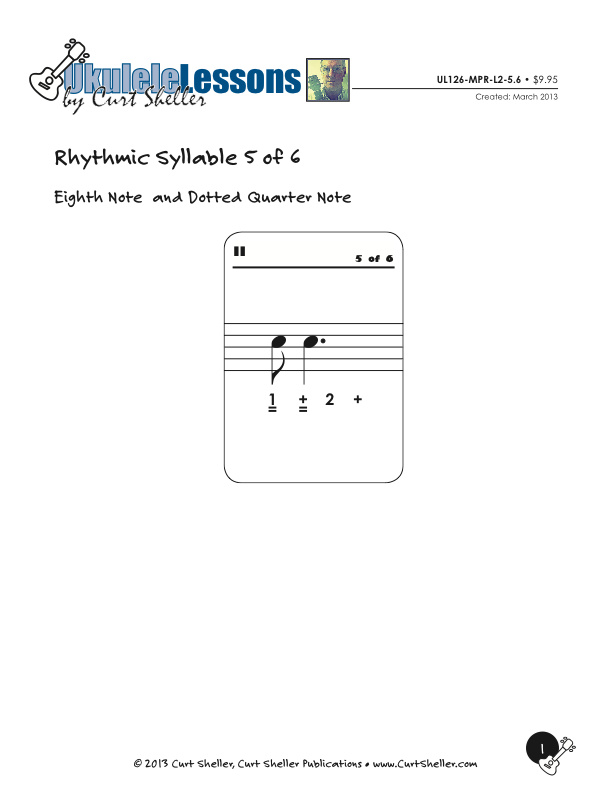
Level II Rhythmic Syllables 5 of 6 from the Modular Phonetic Rhythm, The Foundation and Workbook 1 book.
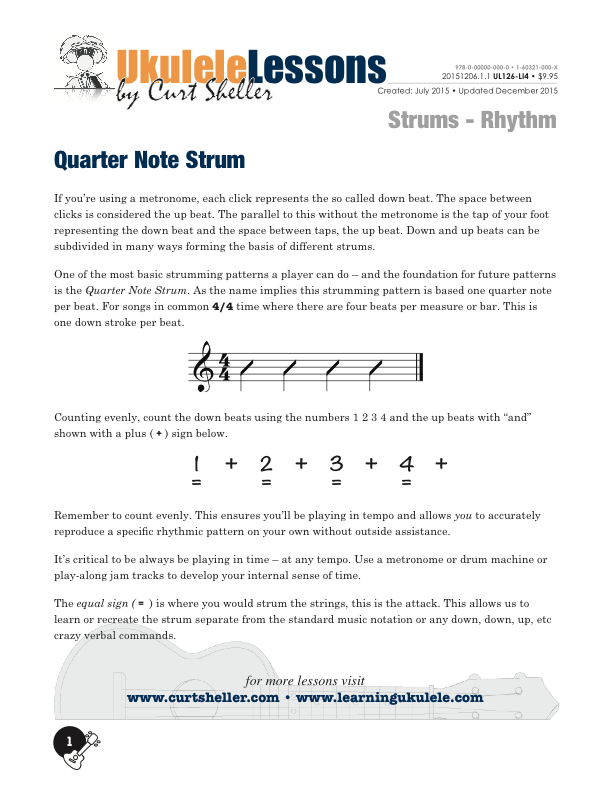
Chords and music are organized into bars or measures with the most common number of beats per bar or measure being four. One of the most basic strumming patterns and the foundation for ALL future strumming is the "Quarter Note Strum". As the name implies this strumming pattern is one quarter note per beat.
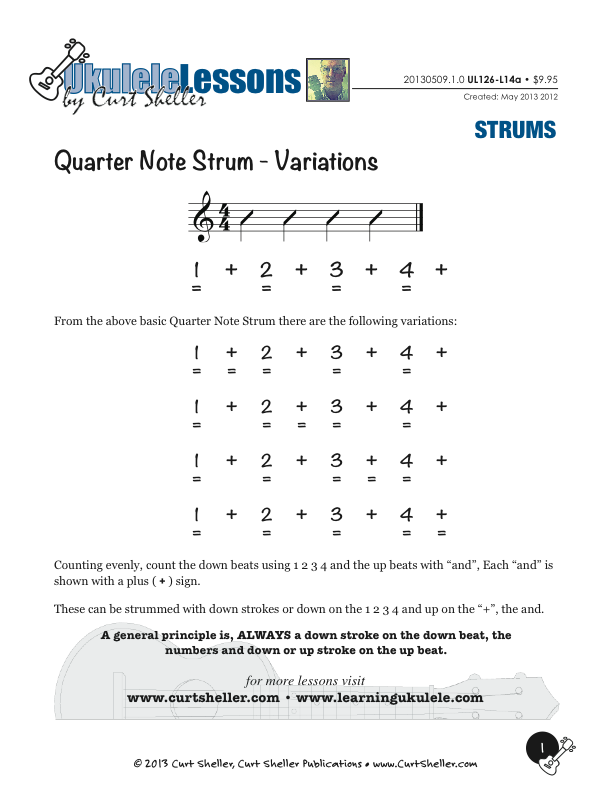
Building on the basic Quarter Note Strum lessons, here are four variations to get you started.
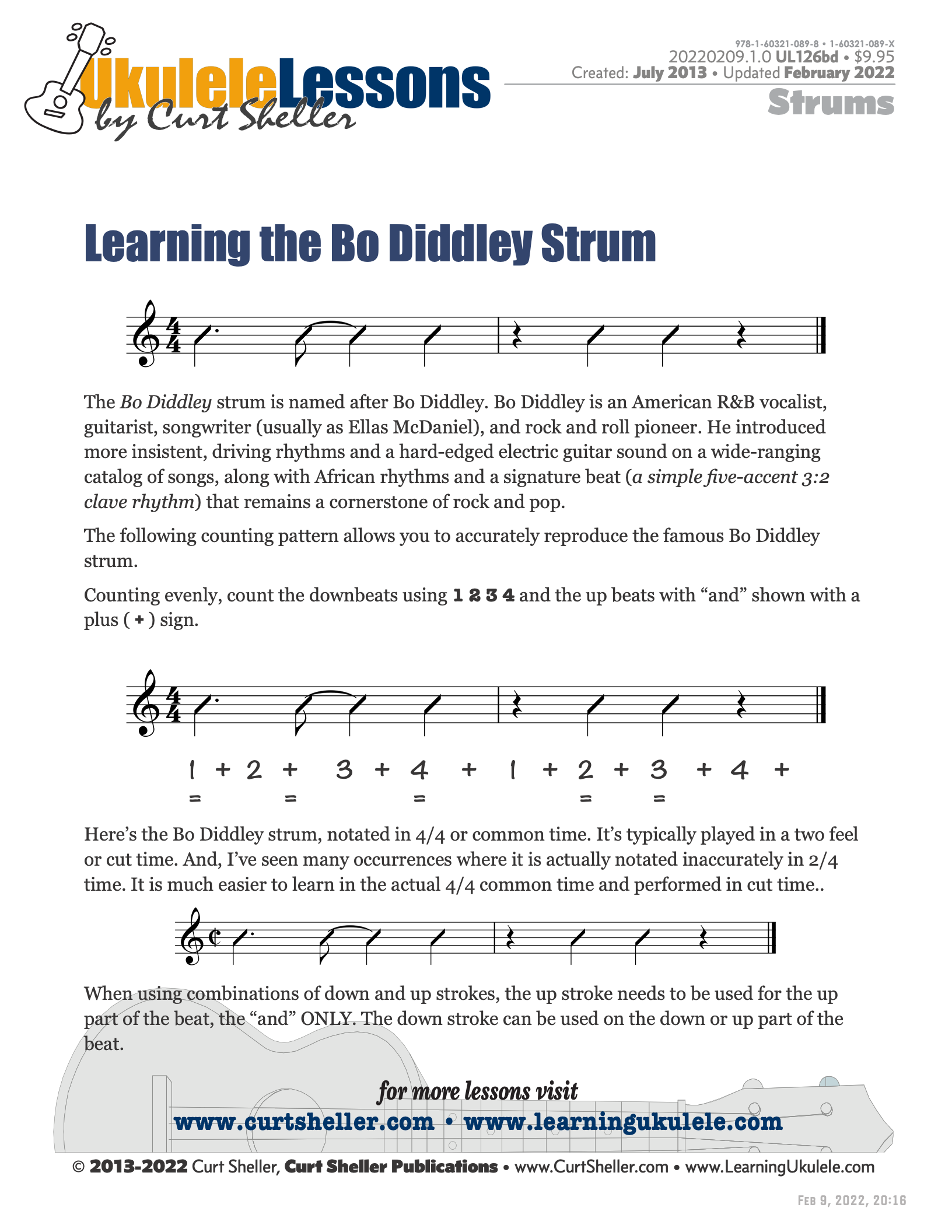
The Bo Diddley strum is named after Bo Diddley. Bo Diddley is an American R&B vocalist, guitarist, songwriter ( usually as Ellas McDaniel ), and rock and roll pioneer. He introduced more insistent, driving rhythms and a hard-edged electric guitar sound on a wide-ranging catalog of songs, along with African rhythms and a signature beat (a simple five-accent clave rhythm) that remains a cornerstone of rock and pop.
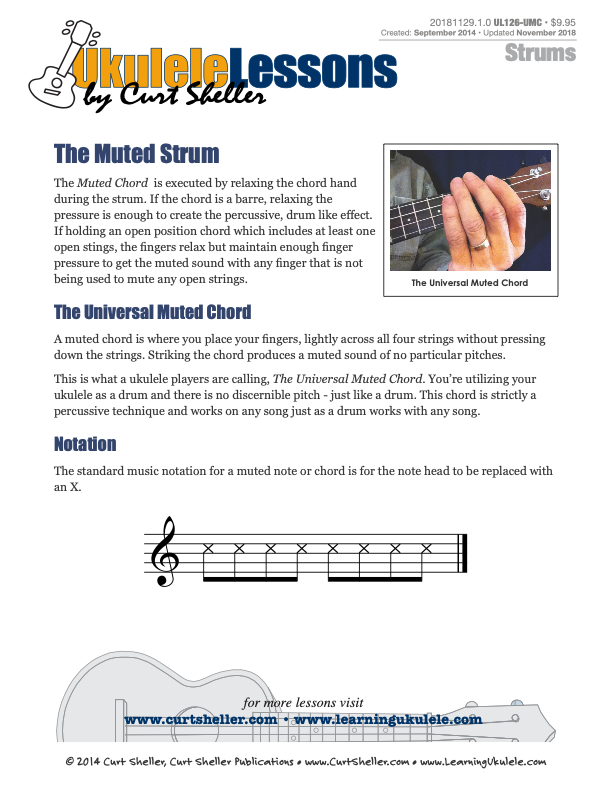
The muted strum is executed by relaxing the chord hand during the strum. If the chord is a barre, relaxing the pressure is enough to create the percussive, drum like effect. If holding an open chord, the fingers relax but maintain enough finger pressure to get the muted sound. This is what a few players are calling, The Universal Muted Chord. You're utilizing your ukulele as a percussive instrument and there is no discernible pitch - just like a drum. This chord works on any song just as a drum works with any song and does't care what the key is. This is a great chord to use when learning a new strum.
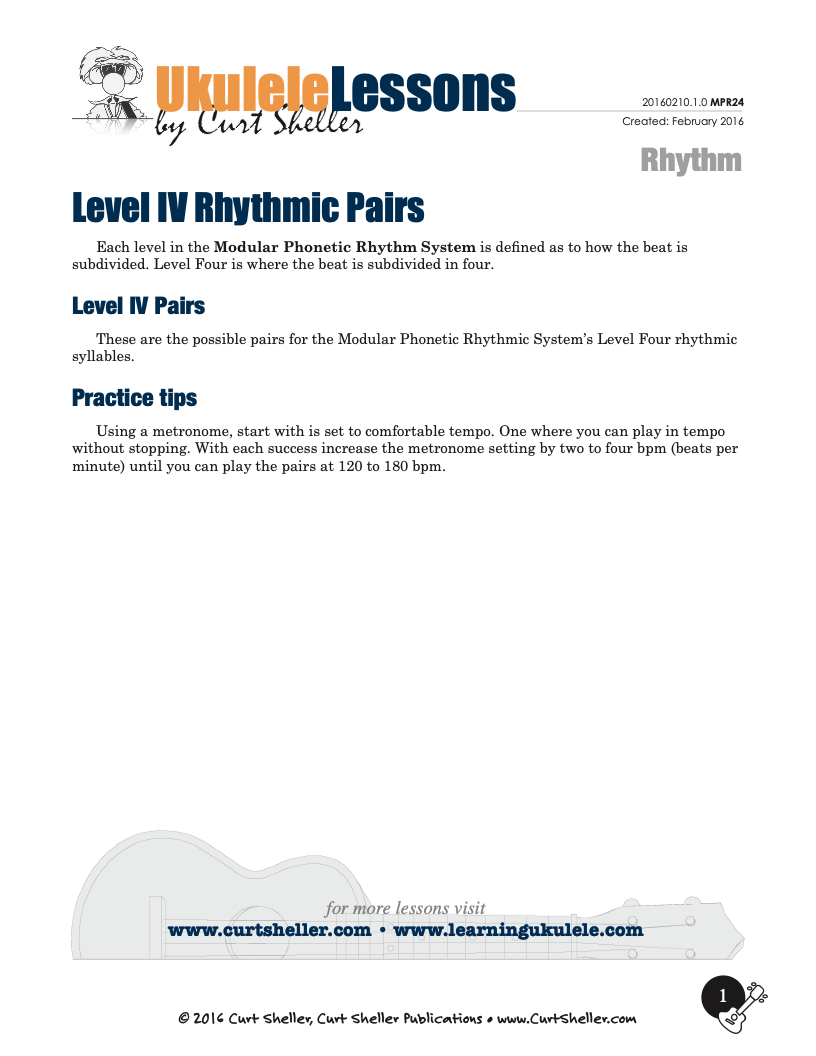
Level IV rhythmic syllable pairs for developing your ukulele strums vocabulary and sharpen your reading chops.
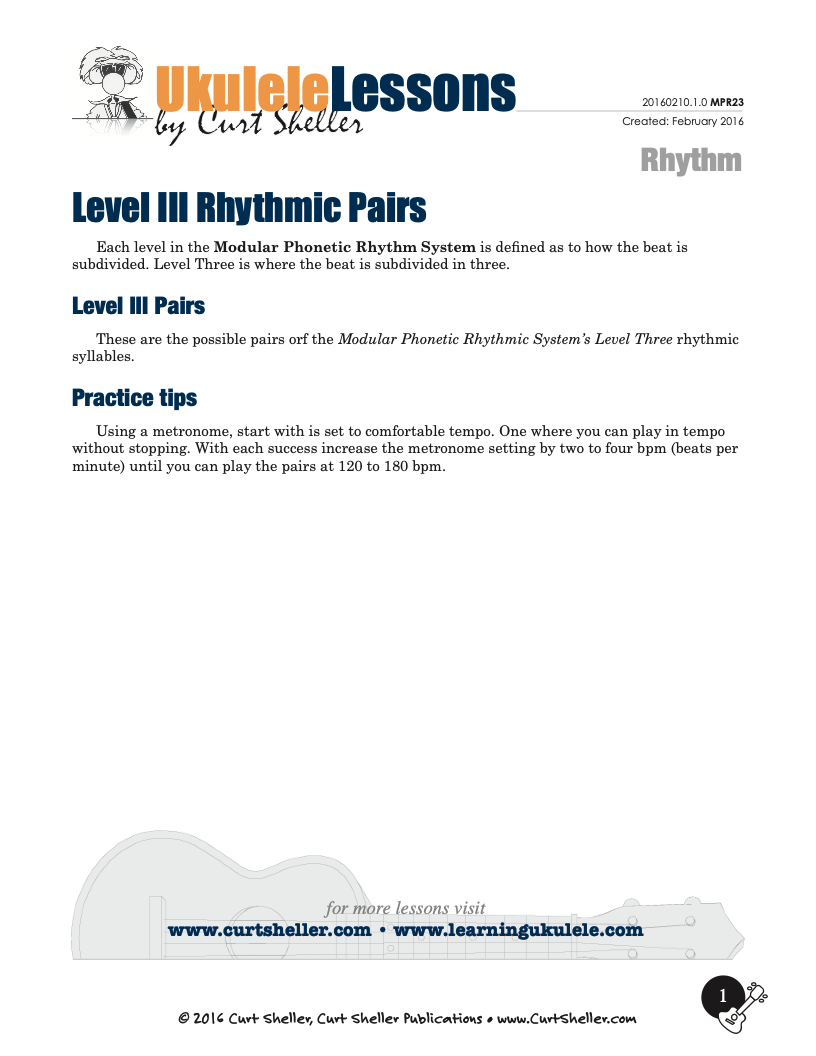
Level III rhythmic syllable pairs for developing your ukulele strums vocabulary and sharpen your reading chops.

Locating the downbeats, pulse, and especially beat one is really important in music. Tracking the downbeats on a strumming instrument like ukulele is really important as it relates to the stroke direction and weak and strong part of downbeats and upbeats. These strong and weak parts of the beat need to be reinforced and telegraphed in order for listeners and fellow musicians to play and follow along.



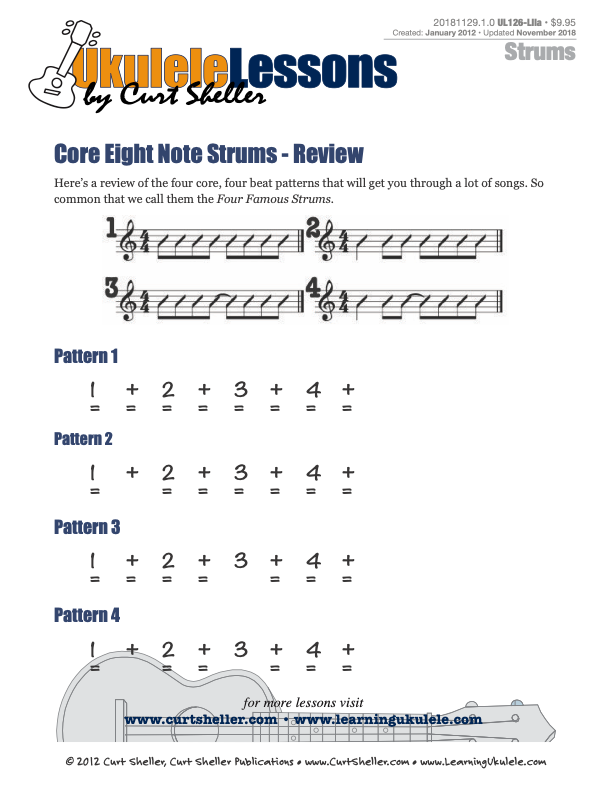
.jpg)